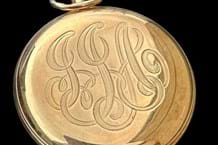Here, rather than dusty heirlooms and furniture passed down through generations guaranteed to pull in the trade, what was on offer were mostly pieces carefully put together in his lifetime by the well-known London interior decorator and dealer Christopher Rowley which proved a magnet for private buyers furnishing their own homes.
And instead of original, untouched material which would need to be taken to the restorers and cleaned up, many of the top sellers had already been through those treatments and came catalogued with all their later additions. Many, in fact, were unashamedly late 19th or even 20th century works carrying the description “style of...” But did this deter buyers? On the contrary – the furnishings of Wormington Manor, near the Cotswold antiques centre of Broadway, could have been specifically geared to modern tastes in which looks are all-important and age and authenticity almost secondary considerations.
This was hardly surprising. Ever since Mr Rowley opened his Bayswater premises in 1963 he and his lifetime friend, George Hughes-Hartman – longtime head of Sotheby’s works of art department and one of the specialists at the 1977 Mentmore sale – were always just a little ahead of the market.
Christopher Rowley was both liked and respected among the trade but on sale days dealers couldn’t compete with private money – from round the world but particularly British money – as buyers picked up the expertise of the man whose interior decorating skills were put to use in some of Britain’s major country houses and London residences.
Sotheby’s expert James Miller said after the sale: “On any particular lot the price often reflected the fact that a bidder had decided he or she was determined to have it in their home and money was not the all-important factor.”
A picture of one of Mr Rowley’s illustrious British Naval forebears (see future Art Market) led the sale but elsewhere his love of French and other Continental work tended to dominate the higher prices such as the Gobelins Portiere Des Dieux tapestry which graced the catalogue cover.
Measuring 11ft 7in by 8ft 7in (3.84 x 2.71m), it was it was one of a set of the four Elements after Claude III Audran by the great Jacques Nielson, who was a major force at the Gobelins workshop from 1749 to 1788. Representing Fire, it showed Jupiter against a gold background astride an eagle, staff in one hand, thunderbolt in another and Ganymede beside him in the folds of his cloak. Below, were a shield with thunderbolt and goat’s mask, cherubs, eaglets martial trophies and burning anthiennes and a central medallion enclosing a burning altar.
Widely researched and with a provenance including HRH Princess Louise, Duchess of Argyle, Rosneath Castle it was estimated at up to £15,000 but sold to a British private bidder at £22,000.
A rather more mundane textile offering did extraordinarily well – five pairs of curtains from the entrance hall estimated at £800-1200 with their removal, warned the catalogue, at the purchaser’s risk and expense.
As Mr Miller commented, curtains are often difficult to sell but in this case quality and provenance combined to bring a private bid of £4800.
The main strength of the sale was, naturally, furniture. As the sale moved from room to room, only faint buying patterns could be discerned but overall, French pieces were in keen demand and German pieces less so. Period material was welcome but quite modern furniture was also keenly fought over, and, this being so, it was no surprise to note that buyers had no objection to later additions or restorations to period items.
A piece which combined most of the above attributes came as early as lot 14 – a stunning Franco-German commode from c.1735 but with an associated brèche violette marble top and later gilt-bronze escutcheons.
The rare 4ft 61/4in (1.238m) wide serpentine three-drawer kingwood marquetry commode with fruitwood inlay featured grotesques and scrolling foliage to the drawer fronts and vases of flowers to the curved sides. It breathed quality, particularly evident in the detail of the marquetry achieved using the hot sand technique to obtain the shading, and was estimated at £20,0000-30,000. In the event, this proved too ambitious and a British private buyer took it at £17,000. But judging from other bids, there seemed no objection at all to later or associated marble tops. The top selling furniture lot was a pair of mid-18th century Piedmontese carved giltwood console tables with a later inset serpentine moulded breccia peach grey and white marble top.
The 4ft 11/2in (1.26m) tables featured scrolled and leaf carved pierced aprons centred by a scallop shell on double scroll leaf-carved legs joined by scrolled pierced and leaf-carved stretchers. Like most Continental furniture, the tables had been regilded but sold around mid-estimate at £18,000 to an American private bidder.
Nor was the later rectangular veined burgundy grey and white marble top and refreshed gilding any sort of handicap to bidding on a single c.1720 Régence giltwood console table.
Sporting a frieze carved with foliage and centred by a mask of Flora, the 4ft 2in (1.22m) wide table on cabriole legs with scallop shells and terminating in scrolled feet was estimated at up to £6000 but was another British private buy at £15,000.
Going less spectacularly above estimate was a c.1750 kingwood and rosewood bombé serpentine commode with an associated moulded brèche d’Alep marble top.
With two short and one narrow centre drawer above two long drawers, there were restorations to the interior and the gilt bronze handles, escutcheons and corner mounts were later, but the 4ft 23/4in (1.29m) Louis XV commode was stamped Chevalier, for Jean-Mathieu and it went past its £12,000 top estimate to a British private buyer at £15,000.
Bidders were a little less enthusiastic about German furniture. A c.1760 kingwood and walnut marquetry bureau from the Upper Rhine with fitted interior was a private sale after the auction at £6000, half the top estimate, although a c.1750 serpentine walnut commode crossbanded on oak, probably South German, went on its top estimate of £7000.
English period furniture was led by a c.1770 pine console table with a 5ft 7in by 2ft (1.70m x 61cm) replaced grey marble top above a frieze applied with anthemion and sprays of foliage on square tapering legs with lappet and leaf-carved detail which made £9500. A c.1800 rosewood sofa table made £7500; a William and Mary oyster walnut chest of two short and three long drawers featuring crossbanding and inlay made £7000 and a Queen Anne walnut chest of two short and three long drawers on a three-drawer stand with later legs took £4500.
All of these sold well above estimate but the real surprises among the English furniture – to traditionalists if not always cataloguers – were those 19th and 20th century pieces described as ‘style of...’
A French private buyer, for instance, repaid the compliment British buyers paid to French furniture when he went to £16,000 for a set of four George I-style giltwood chairs with upholstered velvet backs and seats on square cabriole legs carved with masks, foliage and husk pendants. They had been estimated at £4000-6000.
A pair of George III-style 4ft 11in (1.50m) tall carved giltwood mirrors, with pagoda crestings filled with trellis work and centred by urns, doubled the lower estimate at £12,000.
A couple of pieces with superb looks but clearly catalogued as 20th century were a Regency-style marble-top centre table and a pair of George III-style mahogany and marquetry semi-circular commodes.
The centre table with 4ft 4in (1.32m) diameter Italian black marble top inlaid with specimen marble segments on four carved and gilded dolphins round a central column and on a quatrefoil platform base doubled the lower estimate at £8000. The 4ft 1in (1.25m) commodes with tulipwood and rosewood banding and inlaid panels to the curved cupboards took a top-estimate £4000.
Finally a piece with a copper-bottomed provenance: a pair of Victorian carved giltwood stools with curved X-shaped frames and stuffed seats upholstered in the original red cut velvet. The 20in (51cm) wide stools were provenanced to the Queen Empress herself being stamped during the 1866 royal inventory Windsor Castle Room 190 with the crowned VR 1866 cypher. Estimated at up to £3000 they were a private buy at £10,000.
Sotheby’s Wormington Manor Sale, Worcestershire, July 21, 22
Number of lots offered: 942
Number of lots sold: 921
Sale total: £1.38m (inc. premium)
Buyer’s premium: 20/12 per cent
Contents updated–at £1m
Decorator’s home supplies the demands of today now good looks outrank authentic age: WITH a hammer total of well over £1 million and a 98 per cent selling rate, the on-the-premises contents sale at Wormington Manor, Worcestershire, notched up the sort of figures in the grand tradition of such Sotheby’s events, but in fact it was in many ways much more representative of current trends than past glories.




